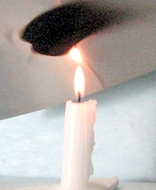

| Observations |
|
 The sales of candles have skyrocketed in the past ten years as marketing and craft vendors continue to push the idea of romance and the humble candle. But, in the last hundred years, only the utility of light was important, as that was frequently the only source of illumination. And, I have to admit that it did seems like a natural extension to think of the candle as an innocuous source of ambiance and scent. In fact, in a recent power outage, the candle was a source of light here as well. But, very recently, I have been working on a project on electrophotography, and needed some fine carbon particles. The candle came to mind as a source of carbon in the form of soot. Not only did I get the carbon, but an education as well.  In less than 15 minutes I had all of the carbon that I needed as the candle deposited its soot on a piece of aluminum. Of course, I thought about how much soot is being inhaled by all of the people using this source of marketing genius. And the answer is a lot. There are several good articles on candle safety and soot generation and they all raise serious concern. That is, all except the National Candle Association, and they say there is no problem. But then, they are probably lobbyists for the oil companies that have tons of left over hydrocarbons to unload, like paraffin, which is a byproduct of gasoline refinement. So, it is likely that the candles that you burn pose a fire risk, inhalation problem, and scents that are unregulated. Just one of the articles can be found here. A better bet would be to use the flickering electronic candles. Let there be light...
0 Comments
Leave a Reply. |
Archives
June 2021
Categories
All
|